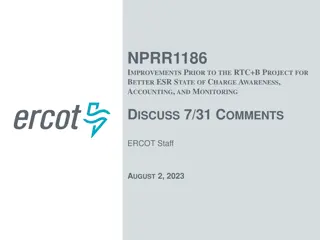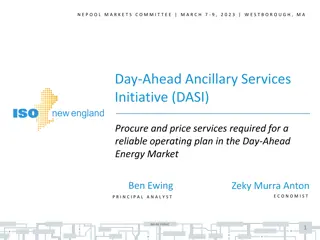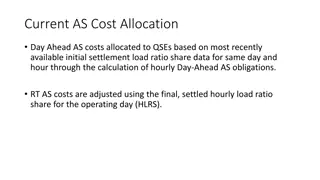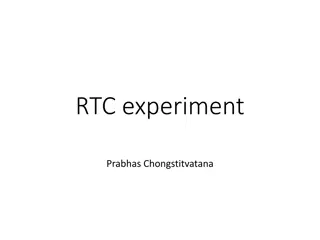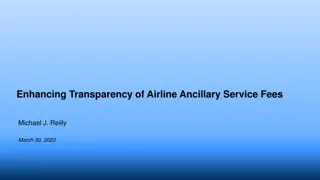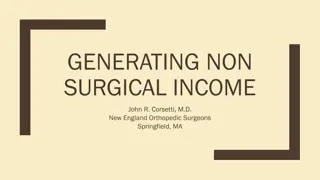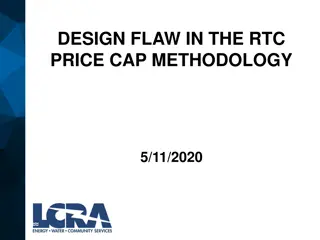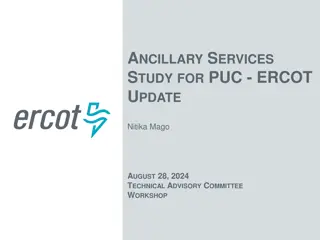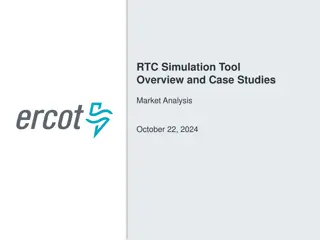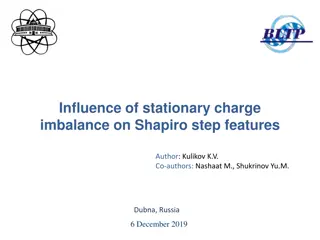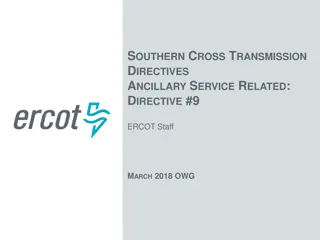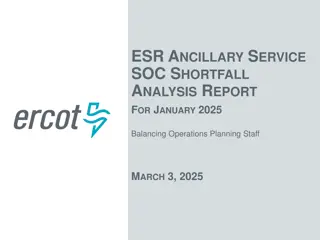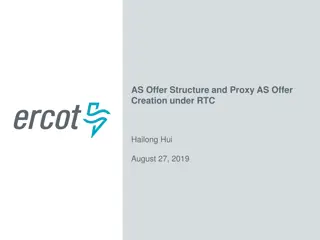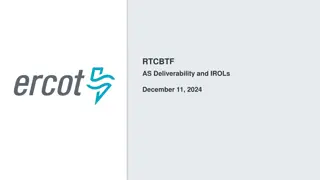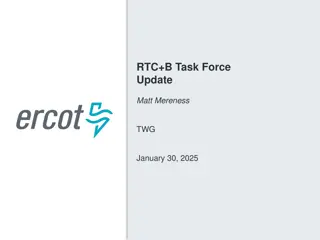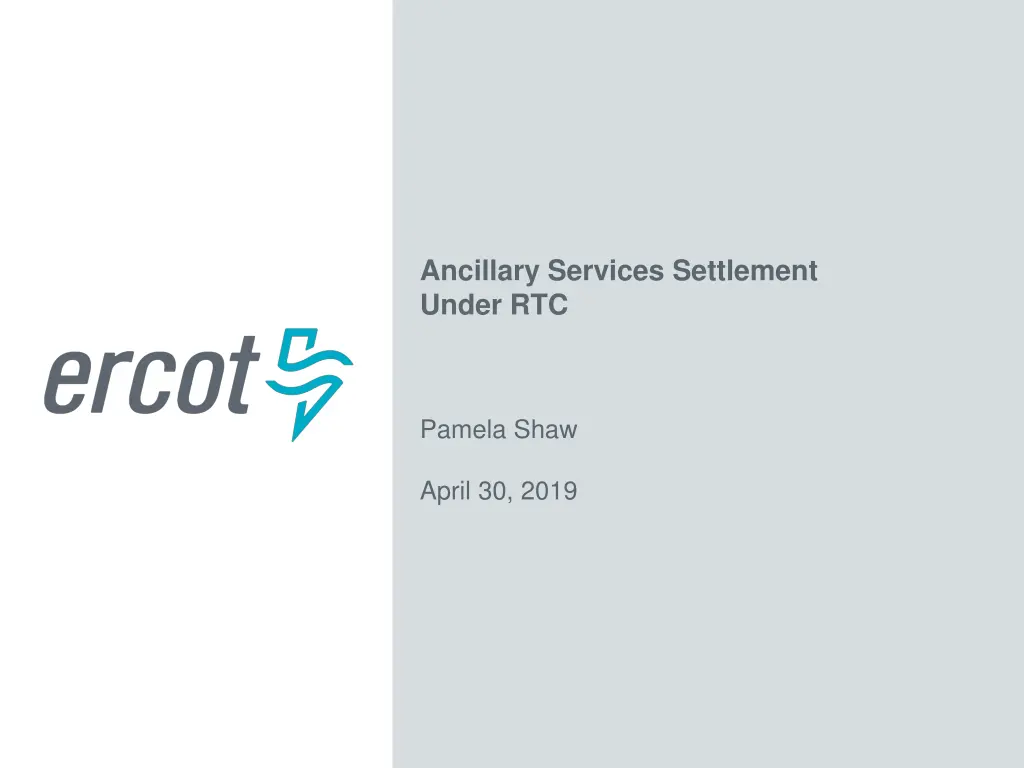
ERCOT Ancillary Services Settlement Process Overview
Explore the detailed process of ERCOT Ancillary Services settlement under the Real-Time Co-optimization (RTC) framework. Learn about market clearing results, supply and demand side settlements, and the adjustments for the Day-Ahead Market (DAM) with RTC in this comprehensive guide.
Download Presentation

Please find below an Image/Link to download the presentation.
The content on the website is provided AS IS for your information and personal use only. It may not be sold, licensed, or shared on other websites without obtaining consent from the author. If you encounter any issues during the download, it is possible that the publisher has removed the file from their server.
You are allowed to download the files provided on this website for personal or commercial use, subject to the condition that they are used lawfully. All files are the property of their respective owners.
The content on the website is provided AS IS for your information and personal use only. It may not be sold, licensed, or shared on other websites without obtaining consent from the author.
E N D
Presentation Transcript
Ancillary Services Settlement Under RTC Pamela Shaw April 30, 2019
Market Clearing Results from DAM and RTM with RTC Current assumption is that there are no or few changes to DAM AS requirements, AS Offer framework (will include 863) and AS clearing in DAM. AS obligations for Load are determined using hourly LRS values from the Operating Day (OD) 7 days back. ERCOT procures ERCOT-wide AS requirements plus or minus the total of the self-arranged quantities submitted by QSEs into DAM. DAM clearing produces hourly MCPCs and hourly Resource-specific AS Awards for each AS product. RTC clears AS with each SCED run (nominally every 5 minutes). RTC clearing produces 5-minute MCPCs and Resource-specific Awards for each AS. The ERCOT-wide quantity of AS cleared in each SCED run may be more or less than the quantity cleared in DAM. 2 PUBLIC
Supply and Demand Side Settlement for the DAM with RTC (same as today) QSEs with Resource-specific AS Awards will be paid the hourly AS price multiplied by the AS Award quantity. QSEs with AS obligation (not covered by self-arrangement) will be charged for each AS. DAM AS settlement is revenue neutral and is based on the obligations determined hourly LRS values for OD 7 days back. All calculations are hourly. 3 PUBLIC
Supply-Side AS Settlement for the RTM with RTC There will be a separate AS imbalance calculation for each AS. AS Award quantities and AS prices for each SCED run (5 minutes) will be used to develop 15-minute AS Resource-specific Award quantities and 15-minute Resource-specific AS prices (RTASMCPCRP). The 15-minute values are determined using weighting factors for the SCED length and the AS Award quantities. AS prices for each SCED run (5 minutes) will be used to develop a 15- minute SCED interval weighted price (RTASMCPC). For each 15-minute period, an imbalance is determined for each QSE by considering the DAM Resource-specific Awards, the DAM self- arranged, and trades all multiplied by the RTASMCPC and the RTC Resource-specific Award quantity multiplied by the RTASMCPCRP. 4 PUBLIC
Demand-Side AS Settlement for the RTM with RTC AS obligations for each QSE are adjusted for the RTM AS settlement. Load data from the actual OD are used instead of the OD from 7 days back. 15-minute LRS values are used in RT AS settlement as opposed to the hourly LRS values that were used in DAM. DAM obligations will be reallocated for a QSE based on RTM LRS multiplied by DAM AS plan. The RTM settlement will pay or charge the QSE based on the difference in the LRS used between DAM and RTM (like today). The RTM AS settlement is revenue neutral, and any residual charges/payments will be allocated on a LRS basis. Depending on system conditions, the ERCOT-wide AS Awards in RTM can potentially be greater than or less than ERCOT-wide AS requirements in DAM which will impact the QSE obligation quantities. 5 PUBLIC
Example Formulas: Regulation Up Service with RTC In the DAM Settlement for each hour: Equation #1: Regulation Up Service Payment; PCRUAMT q= (-1) * MCPCRU DAM* PCRU q Equation #2: Regulation Up Service Charge; DARUAMT q= DARUPR * DARUQ q In the RTM Settlement: Equation #3: DARTPCRUAMTq= (DARUOBL'q * MCPCRUDAM) DARUAMTq Where: DARUOBL'q = (DAM AS Plan) * HLRSq 6 PUBLIC
Example Formulas: Regulation Up Service with RTC In the RTM Settlement: Equation #4: RTRUIMBAMTq = (-1) * (.25) * { r [(RTRUAWDr * RTRUMCPCRPr) - (DARUAWD * RTRUMCPC)] (DARUSA + (RUTP - RUTS)) * RTRUMCPC } Equation #5: LARTRUIMBAMTq = -1 * q RTRUIMBAMT * LRSq Pink = RTC Award * RTC Resource Specific Price Blue = DAM Award * RTC SCED weighted price Purple = DAM Self Arranged * RTC SCED weighted price Green = RU Trades * RTC SCED weighted price 7 PUBLIC
AS Imbalance with RTC Next Steps This approach aligns with energy imbalance today, and ERCOT believes it is the right path for AS imbalance under RTC. What is needed to feel comfortable with this new concept of settling AS? We can bring back examples, but we would like you to tell us which scenarios need more scrutiny. What are the most concerning issues for your business? 8 PUBLIC
Appendix 9 PUBLIC
Ancillary Services Settlement - Current Under the current RTM approach: DAM procures minimum requirements of Ancillary Services. Awards are paid to QSEs in the DAM. AS obligations are based on 7-day back Load Ratio Share. RTM settlements re-allocate the DAM Awards, any SASM Awards, credits for failed quantities and infeasibility. AS obligations are re-allocated based on load QSEs RTM Operating Day Load Ratio Share. 10 PUBLIC
Ancillary Services Settlement - Current Under the current RTM approach: There is one online and one offline ORDC scarcity price for each 5 minutes. QSE capacity is based on online and offline reserves from HSL to RTMG less their AS responsibility. AS imbalance for each QSE is paid or charged based on how much capacity is available on average across a 15-minute interval. The net charge or payment to suppliers is allocated to load QSEs based on LRS. 11 PUBLIC

